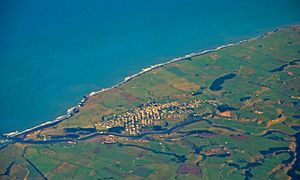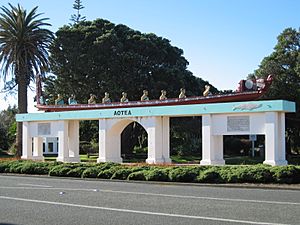Patea facts for kids
Quick facts for kids
Patea
|
|
|---|---|

Aerial photo of Patea
|
|
| Country | New Zealand |
| Region | Taranaki Region |
| Territorial authority | South Taranaki District |
| Ward |
|
| Community | Pātea Community |
| Electorates |
|
| Area | |
| • Total | 6.31 km2 (2.44 sq mi) |
| Population
(June 2023)
|
|
| • Total | 1,270 |
| • Density | 201.3/km2 (521.3/sq mi) |
| Postcode(s) |
4520
|
Patea is a town in the South Taranaki District of New Zealand. It is the third-largest town in this area. Patea is located on the western bank of the Pātea River. It is about 61 kilometres northwest of Whanganui on State Highway 3. The Pātea River flows through the town and into the South Taranaki Bight.
Contents
History and Culture of Patea
Early Māori History
Patea is a very important place for some Māori tribes. Their ancestors, led by Turi, arrived here. They travelled on a large canoe called the Aotea waka. This waka landed at the Aotea Harbour, and Patea became their final home.
European Settlement and Growth
When Europeans first settled here, Patea was sometimes called Carlyle. It was first built closer to the Pātea River mouth. During the New Zealand Wars, Patea was a key military spot. Soldiers built forts on both sides of the river in 1865.
After the wars, Patea grew into a busy market town. The first land plots in the current town area were sold in 1870. A local shipping company started in 1872. The railway line connecting Marton and New Plymouth reached Patea in 1885. Patea officially became a borough (a type of town council) in 1881.
In the 1920s, Patea was famous for exporting cheese. It was the biggest cheese exporting port in the world! Cheese from all over South Taranaki came here. It was then loaded onto ships and sent overseas. The port closed in 1959.
Patea Freezing Works
The Patea Freezing Works started in the early 1880s. It was built on the eastern side of the Pātea River. This factory processed meat and was the main employer in South Taranaki. However, due to changes and problems, it closed in 1982. In 2008, the empty buildings caught fire. The damage was very bad, and the town decided to have them pulled down.
The Pātea Māori Club and "Poi E"
Patea became well-known in 1984 because of the Pātea Māori Club. This group, led by singer Dalvanius Prime, released a song called "Poi E". This song was a huge hit. It helped bring new energy to modern Māori music.
Patea Today
Patea is a town with a strong community spirit. It has many useful services for its residents. These include a medical centre, a public swimming pool, and a rest home. The town is also home to the Aotea Utanganui - Museum of South Taranaki. This museum shares the history of the area.
A few kilometres east of Patea is a small place called Whenuakura. Famous New Zealand golfer Michael Campbell grew up here. He learned to play golf at the Patea Golf Club. In 2005, he won the U.S. Open. He also won the HSBC World Match Play Championship later that year.
Marae in Patea
The local Wai o Turi marae is an important meeting place. Its meeting house is called Rangiharuru. These places are connected to the Ngā Rauru hapū (sub-tribe) of Rangitāwhi. In 2020, the government helped fund improvements to the marae. This project created new jobs for the community.
Patea's Population
Patea covers an area of about 6.31 square kilometres. As of 2018, the town had an estimated population of about 1,191 people. This means there were about 189 people living in each square kilometre.
In 2018, there were 1,191 people living in Patea. This was an increase of 93 people since 2013. The town had 525 households. There were slightly more males than females. The average age in Patea was 46.7 years. About 18.4% of the people were under 15 years old.
Most people in Patea identify as European/Pākehā (60.5%) or Māori (49.1%). Some people also identify as Pacific peoples or Asian. About 7.8% of the people in Patea were born overseas.
When asked about religion, 46.3% of people said they had no religion. About 34.5% were Christian. Some people also followed Māori religious beliefs or other religions.
Education in Patea
Patea has two main schools.
- Pātea Area School teaches students from Year 1 to Year 13 (all school ages). It used to be Patea High School. It became an area school in 2005 when Patea Primary School closed.
- St Joseph's School is a Catholic primary school. It teaches students from Year 1 to Year 6. This school opened in 1904.
Both schools welcome both boys and girls.
Notable People from Patea
Many interesting people have come from Patea, including:
- Vera Burt (1927—2017), a talented international cricketer and field hockey player.
- Eric D'Ath (1897—1979), a professor who studied diseases and legal medicine.
- Len Keys (1880—1958), a lawn bowls player who played for New Zealand. He also helped start bus services in Auckland.
- Cedric Muir (1912—1975), a cricketer who played for Wellington.
- Denise Newlove (born 1973), a Scottish international cricketer.
- Debbie Ngarewa-Packer (born 1966 or 1967), a Member of Parliament and co-leader of the Māori Party.
- Dalvanius Prime (1948—2002), a famous entertainer and songwriter. He recorded "Poi E" with the Pātea Māori Club.
- Codey Rei (born 1989), a rugby union player.
- Alistair Scown (born 1948), a rugby union player.
- Murray Watts (born 1955), a rugby union player.
- Cecil J. Wray (1867–1955), a sports leader who represented New Zealand on the International Olympic Committee.
Climate
| Climate data for Patea (1981–2010) | |||||||||||||
|---|---|---|---|---|---|---|---|---|---|---|---|---|---|
| Month | Jan | Feb | Mar | Apr | May | Jun | Jul | Aug | Sep | Oct | Nov | Dec | Year |
| Mean daily maximum °C (°F) | 21.7 (71.1) |
21.8 (71.2) |
20.7 (69.3) |
18.4 (65.1) |
16.1 (61.0) |
14.3 (57.7) |
13.6 (56.5) |
13.9 (57.0) |
15.5 (59.9) |
16.5 (61.7) |
18.1 (64.6) |
20.4 (68.7) |
17.6 (63.7) |
| Daily mean °C (°F) | 18.0 (64.4) |
18.1 (64.6) |
16.7 (62.1) |
14.7 (58.5) |
12.8 (55.0) |
11.0 (51.8) |
10.1 (50.2) |
10.4 (50.7) |
12.1 (53.8) |
13.1 (55.6) |
14.4 (57.9) |
16.7 (62.1) |
14.0 (57.2) |
| Mean daily minimum °C (°F) | 14.3 (57.7) |
14.5 (58.1) |
12.7 (54.9) |
11.1 (52.0) |
9.4 (48.9) |
7.7 (45.9) |
6.6 (43.9) |
7.0 (44.6) |
8.7 (47.7) |
9.8 (49.6) |
10.6 (51.1) |
13.1 (55.6) |
10.5 (50.8) |
| Average rainfall mm (inches) | 99.8 (3.93) |
81.0 (3.19) |
105.3 (4.15) |
135.6 (5.34) |
147.4 (5.80) |
161.4 (6.35) |
175.0 (6.89) |
151.8 (5.98) |
151.1 (5.95) |
158.4 (6.24) |
182.4 (7.18) |
132.1 (5.20) |
1,681.3 (66.2) |
| Source: NIWA (rain 1991–2020) | |||||||||||||


